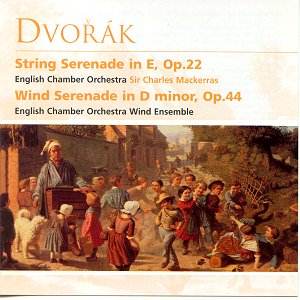Antonin DVORAK
Serenade for Strings in E, Op. 22
Wind Serenade in D minor, Op. 44
 English Chamber Orchestra
- Sir Charles Mackerras
English Chamber Orchestra
- Sir Charles Mackerras
English Chamber Orchestra Wind Ensemble
recorded in 1983 (DDD)
 EMI Classics for Pleasure
574 0042
[54.27]
EMI Classics for Pleasure
574 0042
[54.27]
Crotchet

If you are going to record Dvorak Serenades without Czech forces, then probably
the best alternative is the current one. Sir Charles Mackerras is virtually
an honorary Czech, having spent a good proportion of his time studying and
working in Czechoslovakia. Czech rhythms and inflexions are almost second
nature to him and these show very clearly in the first of these two performances
from Classics for Pleasure.
For some reason, according to the disc details, Sir Charles is not involved
in the Wind Serenade, but it is played by the English Chamber Orchestra Wind
Ensemble. Here the non-Czech provenance is clearer, because of the tone of
the English wind playing compared with the more rustic sound of the Czech
players. Still this is not serious when the music is as well played as it
is.
Dvorak's String Serenade was written in 1875, a very happy year in Dvorak's
life. He had just married his beloved Anna, and had also been awarded a small
government grant as a result of recommendations by Brahms and the music critic,
Eduard Hanslick. Dvorak's state of mind shines through the Serenade for Strings,
being as it is, one of the composer's sunniest works. It is written in five
movements, all of them crafted beautifully with an abundance of melody, which
has made the work one of the most popular works of its kind in the repertoire.
The present performance radiates warmth and pleasure, and the technical expertise
of the English Chamber Orchestra is well up to their usual standard, only
here, inspired by a conductor who has this music in his bones.
The Wind Serenade is in four movements and it bubbles along with high spirits
and again, good tunes are well to the fore, supplementing the composer's
facility in writing for woodwind. This also is evident in other orchestral
works of Dvorak where a mastery of wind writing is clear. It gives much pleasure
to hear this performance played with such élan and high technical
mastery. Dvorak uses a cello and double bass in the composition, so technically
I suppose it is not a true Serenade for wind. Still, no matter, these two
lines are there primarily as support to the lower octaves, rather than
contributing greatly to the melodic makeup of the work.
The Wind Serenade was completed in 1878, and clearly, the effect of his happy
marriage had not dulled in the intervening three years. The four movements,
Moderato, Minuetto, Andante con moto and Finale, keep up the interest without
flagging, and anyone who loves these works will find that there is no need
to look any further for a recording, unless you yearn for the sound of the
rustic Czech woodwinds and wobbly horns. These in themselves conjure up a
unique atmosphere, but I know that many music lovers find the heavy vibrato
of these instruments a little wearing.
My copy had what seems like a slight fault on band 8 between 3'42" and 3'49"
which did not sound as though it was being produced by the players. Check
before you buy.
John Phillips


